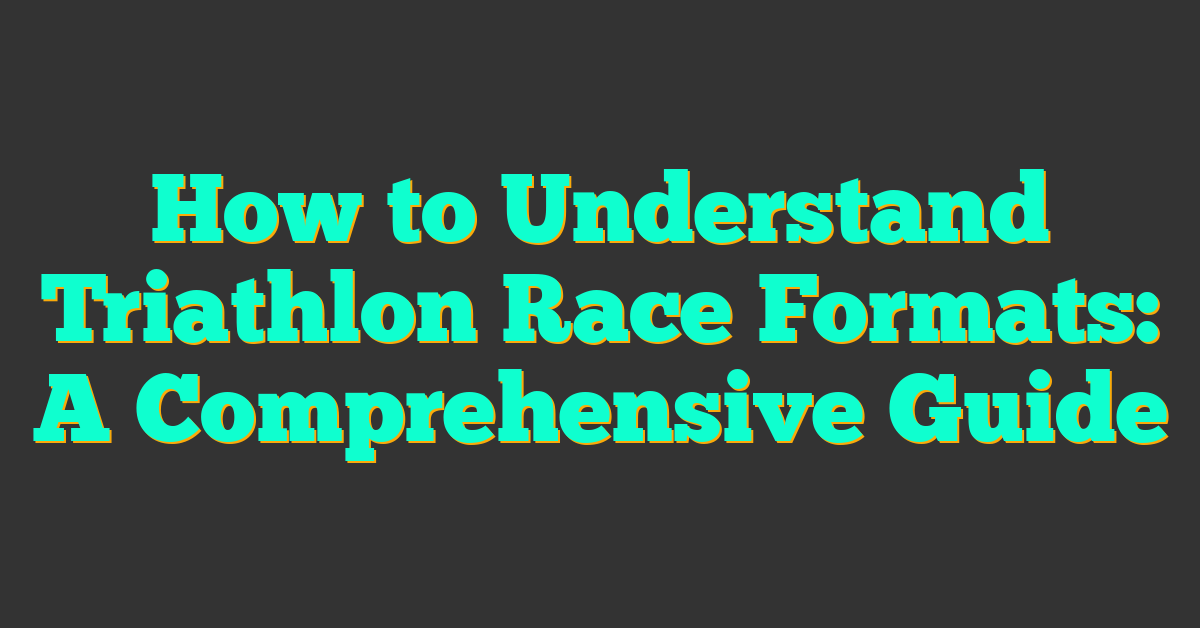I’ve always been fascinated by the diverse formats of triathlon races. From the quick and intense sprint distances to the grueling Ironman challenges each race type offers its own unique set of challenges and rewards.

Understanding the different triathlon formats can help you choose the right race for your fitness level and goals. Whether you’re a seasoned athlete or just starting out knowing what to expect can make all the difference in your training and performance.
In this article I’ll break down the most common triathlon race formats to give you a clear picture of what each entails.
Overview of Triathlon Race Formats
Triathlon races come in various formats, each designed to suit different fitness levels and goals. Understanding these formats helps me choose the right race to match my training and performance objectives. Here are the most common triathlon race formats:
Standard Race Formats
-
Super Sprint Triathlon
- Swim: 400 meters
- Bike: 10 kilometers
- Run: 2.5 kilometers
-
Sprint Triathlon
- Swim: 750 meters
- Bike: 20 kilometers
- Run: 5 kilometers
-
Olympic Triathlon
- Swim: 1.5 kilometers
- Bike: 40 kilometers
- Run: 10 kilometers
-
Half-Ironman (70.3)
- Swim: 1.9 kilometers
- Bike: 90 kilometers
- Run: 21.1 kilometers
-
Ironman
- Swim: 3.8 kilometers
- Bike: 180 kilometers
- Run: 42.2 kilometers
Additional Race Variations
Some triathlons offer unique formats to challenge athletes in different ways:
-
Ultraman Triathlon
- Swim: 10 kilometers
- Bike: 421 kilometers
- Run: 84 kilometers
-
Team Relay Triathlon
- Swim: 300 meters per person
- Bike: 8 kilometers per person
- Run: 2 kilometers per person
Comparison of Triathlon Formats
| Format | Swim Distance | Bike Distance | Run Distance |
|---|---|---|---|
| Super Sprint | 400 m | 10 km | 2.5 km |
| Sprint | 750 m | 20 km | 5 km |
| Olympic | 1.5 km | 40 km | 10 km |
| Half-Ironman | 1.9 km | 90 km | 21.1 km |
| Ironman | 3.8 km | 180 km | 42.2 km |
| Ultraman | 10 km | 421 km | 84 km |
| Team Relay | 300 m/person | 8 km/person | 2 km/person |
This table helps me quickly compare different triathlon formats, making it easier to decide which race aligns with my current fitness level and long-term goals.
Different Types of Triathlon Formats
Choosing the right triathlon format aligns with my fitness level and goals. Here are the most common types:
Sprint Triathlon
Sprint triathlons feature shorter distances, including a 750-meter swim, 20-kilometer bike ride, and a 5-kilometer run. They’re perfect for beginners aiming to experience a triathlon without extensive training.
Olympic Triathlon
Olympic triathlons consist of a 1.5-kilometer swim, 40-kilometer bike ride, and a 10-kilometer run. This standard format suits athletes looking to compete at higher levels and build endurance.
Half-Ironman (70.3)
Half-Ironman races, also known as 70.3, include a 1.9-kilometer swim, 90-kilometer bike ride, and a 21.1-kilometer run. They offer a mid-distance challenge for those ready to push their endurance beyond the Olympic level.
Ironman
Ironman triathlons demand significant endurance, featuring a 3.8-kilometer swim, 180-kilometer bike ride, and a 42.2-kilometer marathon run. These races test the limits of my physical and mental resilience.
Choosing the Right Race Format
Selecting the right triathlon format aligns with my fitness level, training time, and personal goals. I evaluate each race type based on these factors to find the best fit:
- Fitness Level
- Beginner: Sprint and Super Sprint races match my entry-level endurance.
- Intermediate: Olympic and Half-Ironman races suit my growing stamina.
- Advanced: Ironman races challenge my peak endurance and resilience.
- Training Time
- Limited Schedule: Sprint races require fewer training hours, fitting my busy life.
- Dedicated Training: Half-Ironman and Ironman races need extensive preparation, which I pursue when I can commit more time.
- Personal Goals
- Speed Improvement: Sprint races help me focus on faster pacing over shorter distances.
- Endurance Building: Ironman races enhance my long-distance endurance and mental toughness.
- Race Availability
- Local Options: Sprint and Olympic races are often available nearby, making them convenient.
- Specialized Events: Ironman races may require travel, which I plan for well in advance.
Comparison Table of Race Formats
| Race Format | Swim Distance | Bike Distance | Run Distance | Suitable For |
|---|---|---|---|---|
| Super Sprint | 400 meters | 10 kilometers | 2.5 kilometers | Beginners |
| Sprint | 750 meters | 20 kilometers | 5 kilometers | Novices to Intermediates |
| Olympic | 1.5 kilometers | 40 kilometers | 10 kilometers | Intermediate Athletes |
| Half-Ironman (70.3) | 1.9 kilometers | 90 kilometers | 21.1 kilometers | Experienced Triathletes |
| Ironman | 3.8 kilometers | 180 kilometers | 42.2 kilometers | Advanced, Endurance-Focused |
Choosing the right race format ensures that I participate in events that match my capabilities and aspirations, leading to a more enjoyable and rewarding triathlon experience.
Training Considerations for Various Formats
Different triathlon formats require tailored training approaches to meet their specific demands. Each race distance impacts the training volume, intensity, and focus areas necessary for optimal performance.
Super Sprint Triathlon
- Training Volume: Allocate 6-8 hours weekly focusing on shorter, high-intensity workouts.
- Discipline Focus: Emphasize speed in swimming, biking, and running with interval training.
- Recovery: Incorporate sufficient rest days to prevent overtraining due to high intensity.
Sprint Triathlon
- Training Volume: Commit 8-10 hours weekly balancing endurance and speed workouts.
- Discipline Focus: Develop swimming technique, cycling power, and running efficiency.
- Brick Sessions: Practice back-to-back bike and run workouts to enhance transition skills.
Olympic Triathlon
- Training Volume: Dedicate 10-12 hours weekly with a mix of endurance and strength training.
- Discipline Focus: Build aerobic capacity in all three sports with longer training sessions.
- Nutrition: Implement a balanced diet to support increased training demands and recovery.
Half-Ironman (70.3)
- Training Volume: Invest 12-15 hours weekly focusing on sustained endurance.
- Discipline Focus: Incorporate long-distance swims, extended bike rides, and marathon training.
- Pacing Strategy: Develop race-day pacing plans to manage energy across all segments effectively.
Ironman Triathlon
- Training Volume: Engage in 15-20 hours weekly with a strong emphasis on endurance.
- Discipline Focus: Prioritize long-duration training in swimming, biking, and running to build stamina.
- Mental Preparation: Include strategies for mental resilience to cope with the race’s physical and psychological challenges.
Team Relay Triathlon
- Training Volume: Adjust training based on individual roles, typically 6-10 hours weekly per team member.
- Discipline Focus: Specialize in assigned segments while maintaining overall fitness for smooth transitions.
- Team Coordination: Work on synchronization and communication to ensure efficient handoffs and collective performance.
| Triathlon Format | Weekly Training Hours | Key Focus Areas |
|---|---|---|
| Super Sprint | 6-8 | Speed, high-intensity intervals |
| Sprint | 8-10 | Balance endurance and speed |
| Olympic | 10-12 | Aerobic capacity, strength training |
| Half-Ironman | 12-15 | Sustained endurance, pacing |
| Ironman | 15-20 | Stamina, mental resilience |
| Team Relay | 6-10 per member | Specialization, team coordination |
Conclusion
Finding the right triathlon format can make your racing experience truly rewarding. I hope this guide has helped you understand the different race types and how they align with your fitness level and goals.
As you move forward focus on your training and enjoy every moment of your triathlon journey. Whether you’re starting with a sprint triathlon or setting your sights on an Ironman each step brings you closer to your goals. Here’s to a fantastic and fulfilling triathlon experience!










